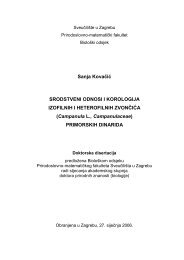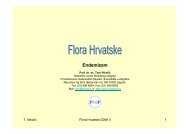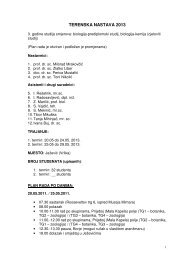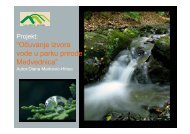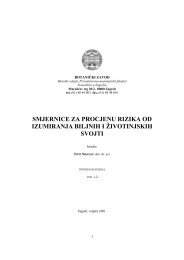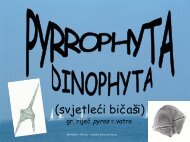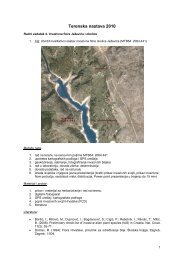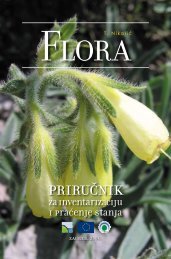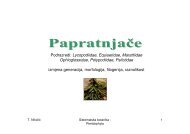important plant areas in central and eastern europe - hirc.botanic.hr ...
important plant areas in central and eastern europe - hirc.botanic.hr ...
important plant areas in central and eastern europe - hirc.botanic.hr ...
You also want an ePaper? Increase the reach of your titles
YUMPU automatically turns print PDFs into web optimized ePapers that Google loves.
Section 5RecommendationsAs key sites for t<strong>hr</strong>eatened <strong>plant</strong>s <strong>and</strong>habitats the follow<strong>in</strong>g actions arerecommended to ensure the susta<strong>in</strong>ableprotection of IPAs <strong>and</strong> their features:■ Ensur<strong>in</strong>g the identity of IPAs as themost significant network for conservationof t<strong>hr</strong>eatened <strong>plant</strong> taxa <strong>and</strong> habitats <strong>in</strong>Europe.■ Develop<strong>in</strong>g a strategic action plan forthe IPA network <strong>and</strong> identify<strong>in</strong>g thepeople <strong>and</strong> organisations to watch overthem <strong>and</strong> to promote them at thenational <strong>and</strong> <strong>in</strong>ternational level.■ Obta<strong>in</strong><strong>in</strong>g protection status for nonprotectedIPAs.Of the 276 IPAs <strong>in</strong> Romania, 20 IPAs (7%), qualify under all t<strong>hr</strong>ee criteria, 179 IPAs (65%)qualify under two criteria <strong>and</strong> 79 IPAs (28%) qualify under one criterion (A or B or C).Seventy-n<strong>in</strong>e IPAs were selected for only one criterion, of these 20 IPAs were selectedfor criterion A species, 21 IPAs for criterion B <strong>and</strong> 38 for criterion C.The highestnumber of Criterion A taxa recorded <strong>in</strong> one IPA was 40 <strong>and</strong> the highest number ofCriterion C habitat types recorded <strong>in</strong> one IPA was 11.Key t<strong>hr</strong>eats to IPAs <strong>in</strong> RomaniaNo. ofIPAs■ Identify<strong>in</strong>g new IPAs (IPA identificationneed to be understood as a dynamic <strong>and</strong>ongo<strong>in</strong>g process).■ Develop<strong>in</strong>g a national IPA monitor<strong>in</strong>gsystem.■ Develop<strong>in</strong>g management plans for IPAsas a part of the national strategy forbiodiversity conservation.■ Organis<strong>in</strong>g a programme on “capacitybuild<strong>in</strong>g for IPA susta<strong>in</strong>ability”■ Rais<strong>in</strong>g awareness among politicians,local communities <strong>and</strong> the general publicabout the importance of IPAs <strong>and</strong> to<strong>in</strong>volve them <strong>in</strong> the IPAprotection <strong>and</strong>conservation.■ Develop<strong>in</strong>g fund<strong>in</strong>g proposals forACTIONS to conserve IPAs!Recreation <strong>and</strong> tourism development is the most widespread t<strong>hr</strong>eat to IPAs <strong>in</strong>Romania (104 IPAs). Intensification or expansion of graz<strong>in</strong>g is also a significant t<strong>hr</strong>eat,occurr<strong>in</strong>g at 80 IPAs <strong>and</strong> general agricultural <strong>in</strong>tensification affects 24 IPAs. Poorforestry practices affect 100 IPAs (deforestation 63 IPAs, afforestation 38 IPAs, IFM<strong>in</strong>tensified forest management 37 IPAs). Habitat fragmentation affects 24 IPAs, often toa high level. Natural events such as drought, disease etc are recorded as t<strong>hr</strong>eats at 43IPAs <strong>and</strong> climate change <strong>and</strong> sea level rise as a low level t<strong>hr</strong>eat at 40 IPAs. Urb<strong>and</strong>evelopment, construction of dams, dykes <strong>and</strong> barriers, <strong>and</strong> <strong>in</strong>appropriate watermanagement systems also t<strong>hr</strong>eatens several IPAs.Significant globally <strong>and</strong> European-level t<strong>hr</strong>eatened habitats, such as coastal dunegrassl<strong>and</strong>s, broadleaved deciduous <strong>and</strong> coniferous woodl<strong>and</strong>, <strong>and</strong> alluvial forest, are stillwell represented <strong>in</strong> Romania. However they are <strong>in</strong>creas<strong>in</strong>gly affected by tourism,agriculture <strong>and</strong> deforestation <strong>and</strong> they require special management measures as soonas possible. Unfortunately the connection between scientific <strong>in</strong>formation <strong>and</strong> politicalwill is still weak <strong>and</strong> <strong>in</strong> many cases even exist<strong>in</strong>g protected <strong>areas</strong> have no realmanagement. Human capacity <strong>and</strong> the necessary <strong>in</strong>frastructure need to be developedto make the protection <strong>and</strong> conservation system work.54



